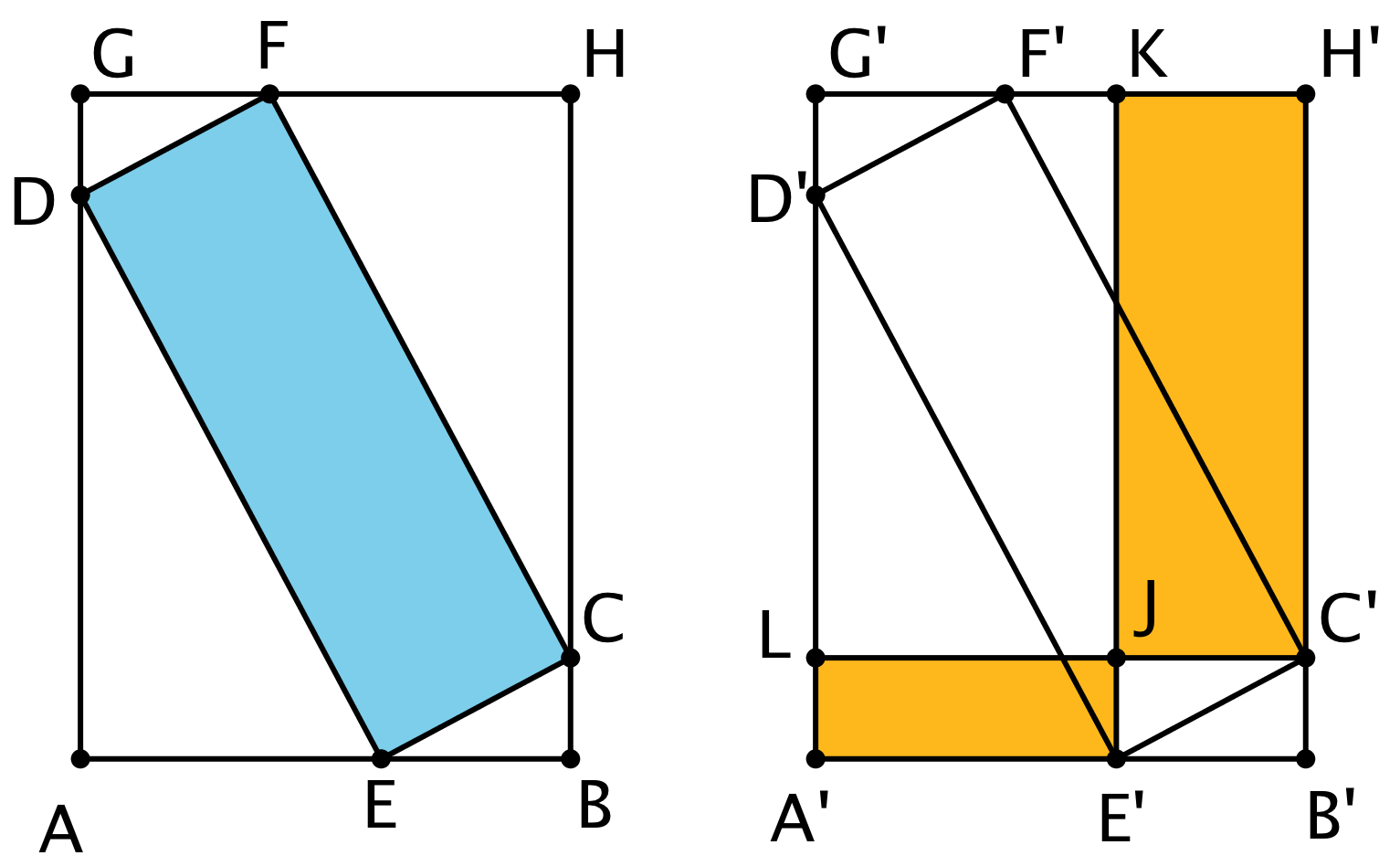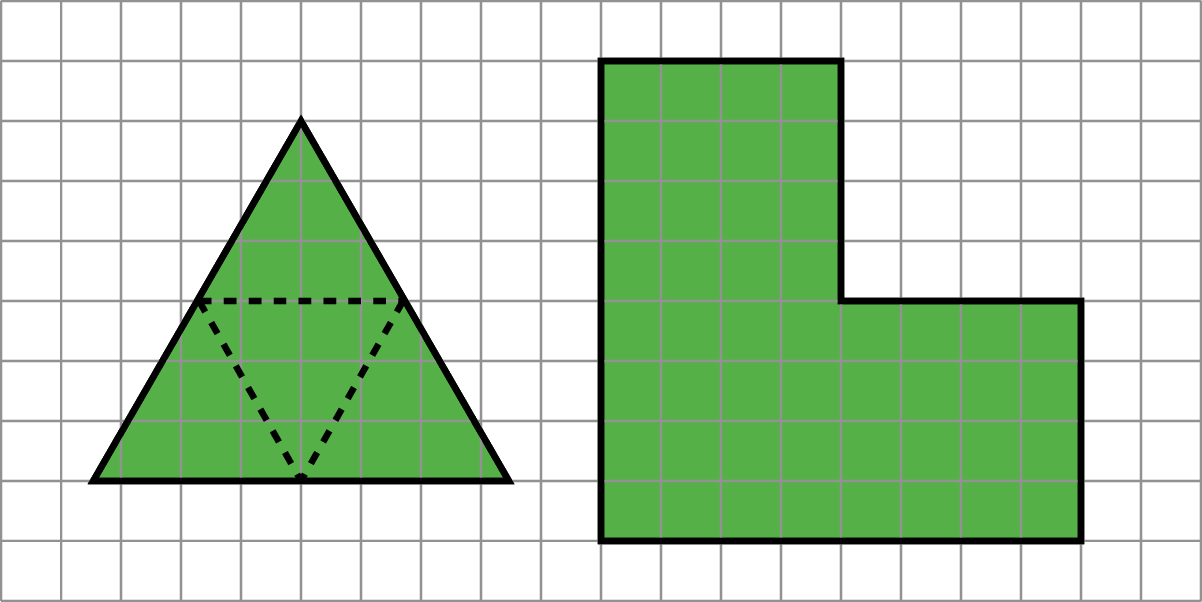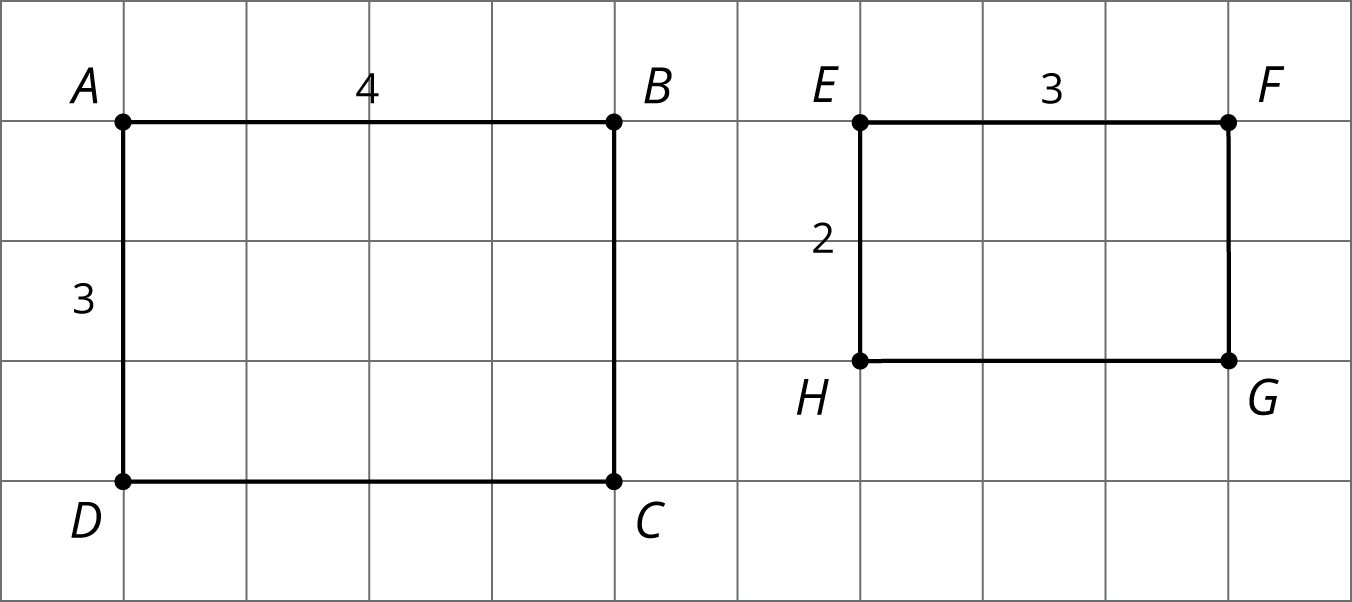Lesson 7
Similar Polygons
7.1: All, Some, None: Congruence and Similarity (10 minutes)
Warm-up
Students examine statements deciding in each case whether the statement is always true, sometimes true, or never true. Since figures are similar if one is the result of reflecting, rotating, translating, and dilating the other, and figures are congruent only as a result of the rigid transformations, congruent figures are similar but not vice versa. Though students have not studied how angles behave under dilations, students have had multiple opportunities to see that dilations influence the size of a shape but not its angles. They also know from work in grade 7 that scaled copies have corresponding angles with the same measure, and dilations have been characterized as a process that makes scaled copies.
Launch
Display all 3 statements. Ask students to decide whether each of the statements is always, sometimes, or never true and give a signal when they have reasoning to support their decision.
Student Facing
Choose whether each of the statements is true in all cases, in some cases, or in no cases.
- If two figures are congruent, then they are similar.
- If two figures are similar, then they are congruent.
- If an angle is dilated with the center of dilation at its vertex, the angle measure may change.
Student Response
For access, consult one of our IM Certified Partners.
Activity Synthesis
Discuss each statement one at a time with this structure:
- Poll the class on their answer choice and display the answers.
- If everyone agrees on one answer, ask a few students to share their reasoning, recording it for all to see.
- If there is disagreement on an answer, ask students with opposing answers to explain their reasoning to come to an agreement on an answer.
7.2: Are They Similar? (10 minutes)
Activity
In the previous lesson, students saw that figures are similar when there is a sequence of translations, rotations, reflections, and dilations that map one figure onto the other. This activity focuses on some common misconceptions about similar figures, and students have an opportunity to critique the reasoning of others (MP3). Two polygons with proportional side lengths but different angles are not similar and two polygons with the same angles but side lengths that are not proportional are also not similar. Reasoning through these problems will help foster student thinking about when two polygons are not similar.
Monitor for students who formulate these ideas for establishing that two figures are not similar:
- The angle measures are different (problem 1).
- The side lengths need to be multiplied by different scale factors in order to match up.
Select these students to share during the discussion.
Launch
Tell students they will look at some polygons that are claimed to be similar. What are some characteristics of similar polygons that are easy to recognize that can be used to confirm or deny the claims? Give 3 minutes of quiet work time followed by a whole-class discussion.
Supports accessibility for: Language; Organization
Student Facing
-

- Now, let’s look at rectangles \(ABCD\) and \(EFGH\).

Jada says, “These rectangles are similar because all of the side lengths differ by 2.” Lin says, “These rectangles are similar. I can dilate \(AD\) and \(BC\) using a scale factor of 2 and \(AB\) and \(CD\) using a scale factor of 1.5 to make the rectangles congruent. Then I can use a translation to line up the rectangles.” Do you agree with either Jada or Lin? Explain your reasoning.
Student Response
For access, consult one of our IM Certified Partners.
Student Facing
Are you ready for more?

Points \(A\) through \(H\) are translated to the right to create points \(A’\) through \(H’\). All of the following are rectangles: \(GHBA\), \(FCED\), \(KH’C’J\), and \(LJE’A’\). Which is greater, the area of blue rectangle \(DFCE\) or the total area of yellow rectangles \(KH’C’J\) and \(LJE’A’\)?
Student Response
For access, consult one of our IM Certified Partners.
Anticipated Misconceptions
Students might think that checking for angle congruence alone can determine similarity. They might also think that just checking if all side lengths have the same scaled value will be enough to determine similarity. However, both the angle sizes and the scale factors must be checked together in determining similarity.
Students might think the side lengths must be different in order for two figures to be similar, but a dilation does not need to be used in the sequence of transformations to show similarity (recall the warm-up where students saw that congruent figures are always similar).
Activity Synthesis
Invite selected students to share their choices and explanations, making sure that these points are highlighted:
- If corresponding angles aren't congruent, then the figures cannot be similar (first problem).
- If the side lengths are not all scaled by the same value, then the figures cannot be similar (second problem).
Unlike what Clare says, the same dilation (with the same scale factor) has to be performed to all parts of a figure to result in a similar figure. Another way to state the two important conclusions above is that for similar polygons:
- Corresponding angles are congruent.
- Corresponding side lengths are proportional.
Design Principles(s): Optimize output (for explanation); Maximize meta-awareness
7.3: Find Someone Similar (15 minutes)
Activity
In the previous activity, students learn that in order to be similar, two figures must have congruent corresponding angles and proportional corresponding side lengths. In this activity, students apply this knowledge. Each student has a card with a figure on it and they identify someone with a similar (but not congruent) figure.
Monitor for students using these methods to identify a partner:
- Process of elimination (figures with different angle measures cannot be similar to one another)
- Looking for the same kind of figure (rectangle, square, rhombus)
- Looking for a the same kind of figure with congruent corresponding angles
- Looking for a the same kind of figure with corresponding sides scaled by the same scale factor
Launch
Distribute one card to each student. Explain that the task is for each student to find someone else in the class who has a similar (but not congruent) figure to their own, and be prepared to explain how they know the two figures are similar.
If the number of students in class is not a multiple of 10, ensure that any unused cards are matching pairs of similar figures. If there is an odd number of students, one or more students can be responsible for two cards, or some students can be appointed as referees.
Supports accessibility for: Conceptual processing
Design Principle(s): Support sense-making; Maximize meta-awareness
Student Facing
Your teacher will give you a card. Find someone else in the room who has a card with a polygon that is similar but not congruent to yours. When you have found your partner, work with them to explain how you know that the two polygons are similar.
Student Response
For access, consult one of our IM Certified Partners.
Student Facing
Are you ready for more?
On the left is an equilateral triangle where dashed lines have been added, showing how you can partition an equilateral triangle into smaller similar triangles.

Find a way to do this for the figure on the right, partitioning it into smaller figures which are each similar to that original shape. What’s the fewest number of pieces you can use? The most?
Student Response
For access, consult one of our IM Certified Partners.
Anticipated Misconceptions
If students have a hard time getting started, ask them to focus on properties of their figure that will be shared by a similar figure. For example, will a similar figure be a quadrilateral? Will a similar figure be square? A rectangle? A rhombus? What can you say about the angles in a similar figure?
Activity Synthesis
Invite selected students to share how they found a partner. Highlight different strategies: it is possible to proceed by process of elimination (this shape is a rectangle and mine is not so it is not a match) or by actively looking for certain features (e.g. a rhombus whose angle measures are 60 degrees and 120 degrees). Next ask how they knew their polygons were similar and which scale factor they used to show similarity.
Ask students what they looked for in searching for a partner with a similar figure. In particular ask
- “Were the side lengths important?” (For some figures, such as the rectangles, the side lengths were important.)
- “Were the angles important?” (Yes. Several of the figures had different angles and that meant they were not similar.)
Students may notice that all squares are similar since they have 4 right angles and proportional side lengths. On the other hand, this activity provides examples of rhombuses that are not similar to one another.
Lesson Synthesis
Lesson Synthesis
Important take aways from this lesson include:
- Similar figures have congruent corresponding angles and proportional corresponding side lengths.
- For some figures (like rectangles or squares), it is sufficient to focus on side lengths since corresponding angles are automatically congruent.
- For some figures (like rhombuses), it is sufficient to focus on angles since corresponding side lengths are automatically proportional.
Make sure students understand that, in general, determining whether two polygons are similar requires examining both side lengths and angles. On the other hand, it is possible to determine that two polygons are not similar by identifying a single pair of corresponding angles whose measures are different or a pair of corresponding side lengths with a different ratio than another pair of corresponding side lengths.
7.4: Cool-down - How Do You Know? (5 minutes)
Cool-Down
For access, consult one of our IM Certified Partners.
Student Lesson Summary
Student Facing
When two polygons are similar:
- Every angle and side in one polygon has a corresponding part in the other polygon.
- All pairs of corresponding angles have the same measure.
- Corresponding sides are related by a single scale factor. Each side length in one figure is multiplied by the scale factor to get the corresponding side length in the other figure.
Consider the two rectangles shown here. Are they similar?

It looks like rectangles \(ABCD\) and \(EFGH\) could be similar, if you match the long edges and match the short edges. All the corresponding angles are congruent because they are all right angles. Calculating the scale factor between the sides is where we see that “looks like” isn’t enough to make them similar. To scale the long side \(AB\) to the long side \(EF\), the scale factor must be \(\frac34\), because \(4 \boldcdot \frac34=3\). But the scale factor to match \(AD\) to \(EH\) has to be \(\frac23\), because \(3\boldcdot \frac23=2\). So, the rectangles are not similar because the scale factors for all the parts must be the same.
Here is an example that shows how sides can correspond (with a scale factor of 1), but the quadrilaterals are not similar because the angles don’t have the same measure:
